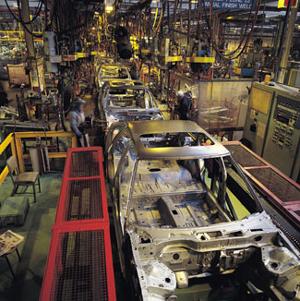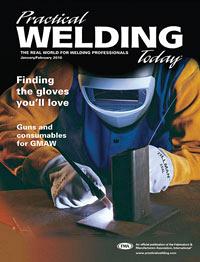Senior Product Manager, Cored Wires
- FMA
- The Fabricator
- FABTECH
- Canadian Metalworking
Categories
- Additive Manufacturing
- Aluminum Welding
- Arc Welding
- Assembly and Joining
- Automation and Robotics
- Bending and Forming
- Consumables
- Cutting and Weld Prep
- Electric Vehicles
- En Español
- Finishing
- Hydroforming
- Laser Cutting
- Laser Welding
- Machining
- Manufacturing Software
- Materials Handling
- Metals/Materials
- Oxyfuel Cutting
- Plasma Cutting
- Power Tools
- Punching and Other Holemaking
- Roll Forming
- Safety
- Sawing
- Shearing
- Shop Management
- Testing and Measuring
- Tube and Pipe Fabrication
- Tube and Pipe Production
- Waterjet Cutting
Industry Directory
Webcasts
Podcasts
FAB 40
Advertise
Subscribe
Account Login
Search
Gas-shielded cored wires find their niche
Suitable applications for flux-cored and metal-cored electrodes
- By Dwight Myers
- June 15, 2001
- Article
- Consumables
Gas-shielded flux-cored arc welding (FCAW) and metal-cored arc welding (MCAW) are growing in popularity for many applications. To determine if these wires should be used, shop managers should understand how formulations of cored wires do or do not fit their quality requirements for certain applications.
Gas-shielded flux-cored wire applications often include an external shielding gas and have a slag system that helps to clean and protect the molten weld puddle, not unlike that of a shielded metal arc, or stick, welding (SMAW) electrode. The slag also acts as a shelf and aids out-of-position welding.
Metal-cored wires also require an external shielding gas but, unlike flux-cored wires, do not have a slag covering the weld deposit.
Metal-cored wires generally have arc characteristics and weld deposits similar to a solid gas metal arc, or MIG, welding (GMAW) wire.Cored wires, whether flux-cored or metal-cored, are fabricated wires. They usually are produced from a thin, flat ribbon of steel that is formed into a U shape, filled with the flux and alloy formulation, and then closed into a tube with the flux and alloy on the inside. Because they are fabricated, the wires can be adapted to meet many welding requirements.
The core ingredients of fabricated cored wires can be formulated specifically to give them the most suitable combination of mechanical properties, weldability, and productivity for the task at hand. The fabrication process accounts for the increased electrode cost compared to solid GMAW wire.
Deposition efficiency is the measure of how much wire actually becomes deposited weld metal. Solid GMAW wires generally exhibit 95 to 98 percent efficiency, metal-cored wires exhibit 92 to 95 percent efficiency, and flux-cored wires exhibit 85 to 89 percent efficiency. Although the deposition efficiencies of gas-shielded flux-cored and metal-cored wires are lower than those for solid GMAW wires, their higher deposition rates, or the amount of weld metal deposited per hour, as well as their contribution to weld quality help offset the higher costs in applications that lend themselves to cored wire.
This article presents some of the welding applications and benefits for which cored wires can be a good choice for the fabricator.
All-position Flux-cored Wires
All-position versatility is one of the greatest benefits offered by flux-cored wires. Over the years, developments in the flux-cored wire process have allowed these wires to be used for welding in all positions (including vertical and overhead) while maintaining the good mechanical properties and high productivity allowed by the high deposition rates in all positions.
Welding is restricted primarily by the amount of weld metal that can be deposited and handled when making a good-quality weld. The temperature of the weld pool, the fluidity of the weld metal, and slag play important roles in allowing out-of-position welding.
Not all flux-cored wires will perform out of position. American Welding Society (AWS) A5.20 E70T-X wires are designed for flat and horizontal welding only. Flux-cored wires that are designed for all-position welding (classified as E71T-X by AWS) include arc stabilizers and slag systems that are formulated to support the weld pools in out-of-position welding with a faster-freezing slag.
The outer metallic sheaths of a flux-cored wire conduct the electrical current for welding. Because of the fabricated, composite nature of cored wires, their current-carrying density is greater, which improves the deposition rates at lower current levels by depositing more metal per inch of wire at equal wire feed speeds when compared to other welding processes.
All-position flux-cored wires include arc stabilizers and slag systems that are formulated to support the weld pools, resulting in fast-freezing slag. The conducting part of cored wires is small, which results in high current density and helps to improve their net deposition rates.
The productivity and manageability of this process make FCAW suitable for a variety of positioned and all-positional applications. These include building dock assembly, pipe welding, shipbuilding, and welding of other structures and fabrications that cannot be done in the flat position.
Because flux-cored wires have a slag covering the weld, postweld removal of the slag is necessary. However, the slag generally is easy to remove and, in some cases, almost self-releasing.
In addition, the decision to use gas-shielded flux-cored wires depends on the availability of shielding gas at the fabrication site. When welding is performed on a remote site and the appropriate shielding gas is not accessible, a self-shielded flux-cored wire, which generates its own shielding gas from the core ingredients, may be a better choice.
Welding with gas-shielded flux-cored and metal-cored wires creates a wide, deep-penetrating arc. The resulting penetration and smooth tie-in of welds help to decrease the occurrence of defects caused by lack of penetration and lack of sidewall fusion sometimes found in applications using solid GMAW wires at low current settings.
The weld pool created by flux-cored and metal-cored wires generally is calm and flat, which creates a consistent weld and smooth wash or wet-in on both legs of a fillet or both sides of a weld.
Because fusion defects generally are minimal with flux-cored and metal-cored wire welding, industries such as offshore fabrication, railcar, shipbuilding, and heavy machinery and earth-moving equipment fabrication are using this process.
Metal-cored Wires
In an effort to achieve higher deposition rates and higher deposition efficiencies to lower the cost per pound of welding material deposited, filler metal manufacturers working with industrial fabricators developed metal-cored wires. These wires combine the high deposition rates of flux-cored wires with the high deposition efficiencies of solid-wire GMAW.
The composition of the filler for fabricated metal-cored wires is predominantly metallic powders, which are responsible for the high deposition rates. Like flux-cored wires, metal-cored wires can be produced with specific alloy compositions for a wider electrode selection for specific application requirements while allowing the purchase of smaller heats compared to the full melt of a solid GMAW wire.
The fabricated nature of metal-cored wires (produced similarly to flux-cored wires), along with their high deposition rates, high deposition efficiencies, high duty cycles, and low slag and spatter, makes them suitable for high-production welding, including automatic and robotic applications. In essence, metal-cored wires are able to exhibit up to a 30 percent increase in travel speed over a solid GMAW wire to keep up with the continuous, high travel speeds required for automatic or robotic welding while maintaining bead appearance, penetration, and weld integrity.
Compared to flux-cored wires, metal-cored wires contain smaller amounts of arc stabilizers and little or no slag-forming ingredients. The resulting weld deposit of a metal-cored wire is very similar to that of a solid GMAW wire, with only a few easily removed silicon islands on the weld surface. This allows metal-cored wires, like their solid GMAW wire counterparts, to be used commonly for multipass welding because they can achieve productive high speeds, and deslagging after every welding pass is not necessary.
The automotive industry was one of the first to use robotics; today, one of the most widespread uses of metal-cored wires in robotic welding is for the exhaust systems of new cars. Metal-cored wires were adapted to the changes in the alloyed steels developed to increase the life of exhaust systems. Their ability to bridge gaps makes metal-cored wires a suitable choice when precise part fit-up is not possible.
One-sided Welding with Ceramic Backing
Flux- and metal-cored wires are particularly suitable for one-sided welding on open butt joints. Open butt joint welding requires a high skill level to achieve sufficient penetration with back-bead reinforcement and burn-through prevention. With cored wires and ceramic backing, however, the welder can choose a wire and match it with backing materials selected for optimum results in all welding positions while maintaining a high productivity level.
Because the cored-wire process is one of the easiest welding processes to master, the welder can achieve high productivity with one-sided welding. One-sided welding with cored wires and ceramic backing also will reduce the amount of preweld setup and postweld machining because back-gouging or grinding is not required.
Low-fume Cored-wire Welding
Cored wires typically generate more fumes than other continuous welding processes because the cored wires deposit more weld metal per minute.
In recent years, manufacturers have introduced cored wires that produce less welding fume and spatter. Cored wires have been formulated for use with high-argon gas mixtures previously used only for solid-wire GMAW. This use of special low-fume cored wires with a deposition chemistry balance for the use of higher-argon shielding gas mixtures tends to lower the fume and spatter levels commonly associated with flux-cored wires.
These products are suitable for use in situations in which operator and industrial hygiene concerns make low-fume production a priority. The higher cost of these products can be weighed against the cost-effectiveness of achieving a low-fume environment through other means—such as electrical precipitators and mechanical fume extraction systems —to determine the most economical approach to lowering fume generation on the shop floor.
Conclusion
Through a thorough understanding of MCAW and FCAW, welders doing various types of welding have been able to identify niches in which cored wires can contribute to higher productivity and quality improvements. The differences in flux formulations among different cored-wire products permit flexibility in meeting specific performance needs and end-result requirements.
Not all applications are suitable for cored wires, but end users should be aware of the basic economics of welding to determine the actual cost per pound of deposited weld metal (rather than cost per pound of product) to choose the best wire for a particular application.
About the Author
Dwight Myers
801 Wilson Ave.
Hanover, PA 17331
717-637-7651
About the Publication
subscribe now

The Welder, formerly known as Practical Welding Today, is a showcase of the real people who make the products we use and work with every day. This magazine has served the welding community in North America well for more than 20 years.
start your free subscription- Stay connected from anywhere

Easily access valuable industry resources now with full access to the digital edition of The Fabricator.

Easily access valuable industry resources now with full access to the digital edition of The Welder.

Easily access valuable industry resources now with full access to the digital edition of The Tube and Pipe Journal.
- Podcasting
- Podcast:
- The Fabricator Podcast
- Published:
- 04/16/2024
- Running Time:
- 63:29
In this episode of The Fabricator Podcast, Caleb Chamberlain, co-founder and CEO of OSH Cut, discusses his company’s...
- Industry Events
16th Annual Safety Conference
- April 30 - May 1, 2024
- Elgin,
Pipe and Tube Conference
- May 21 - 22, 2024
- Omaha, NE
World-Class Roll Forming Workshop
- June 5 - 6, 2024
- Louisville, KY
Advanced Laser Application Workshop
- June 25 - 27, 2024
- Novi, MI
































